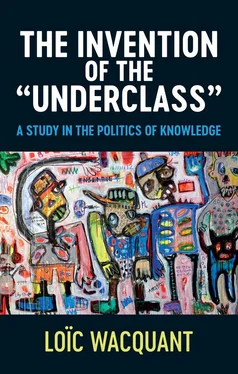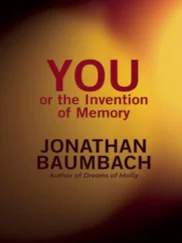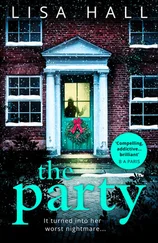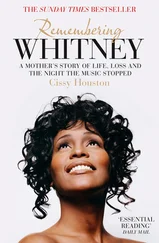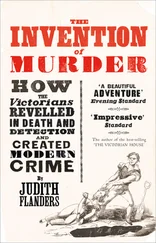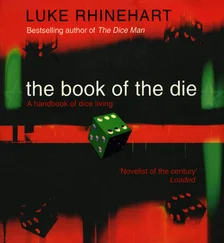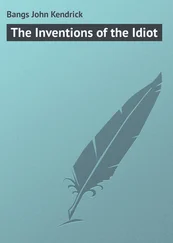Whence comes this turbid notion of “underclass,” how is the semantic space it describes configured, and what are the reasons for its sudden, if short-lived, success at the cutting edge of urban and policy research? And what lessons can be garnered from its strange career for the sociology of caste and class in the polarizing metropolis? An abbreviated genealogy takes us from the world of scholarship, to philanthropy and policy institutes, to journalism and the bureaucratic state, and back to think tanks and the university, each cluster of protagonists finding symbolic profit in the endorsement of the category by the others, so that the fiction of the “underclass” gains credibility by circulating across the boundaries of the academic, political-policy-philanthropic and journalistic fields . 4
Issued from the scholarly and public debates of the 1960s that fueled the launching of President Johnson’s “War on Poverty,” the term was coined in 1963 by the Swedish economist Gunnar Myrdal in a book alerting America to the ominous formation of a stratum of the working class that was being permanently marginalized by postindustrialization. 5Myrdal used the term to refer to a new position in the labor market and class structure. But the “underclass” failed to make a mark in university, media, and government circles because two rival notions captured the public imagination at that time: Daniel Patrick Moynihan’s “tangle of pathology” and Oscar Lewis’s “culture of poverty.” Applying Koselleck’s prescriptions for conceptual history, we must grasp these three notions in their interrelationships as part of a single “historical arrangement” of mental constructs emerging in the political turmoil of the mid-1960s. And, consistent with Bourdieu’s theory of classification struggles, we must spotlight the contest to establish one or another label as the right diagnosis for the ills of the collapsing ghetto.
The explosive expression “tangle of pathology” was not Moynihan’s; it was coined by the renowned black psychologist Kenneth B. Clark in a report to Harlem Youth Opportunities Unlimited, a community action program, that served as basis for his book, Dark Ghetto: Dilemmas of Social Power , published to considerable acclaim in 1965 amidst the race riots shaking the country from coast to coast. In that book, Clark wrote somberly:
The dark ghetto is institutionalized pathology, it is chronic, self-perpetuating pathology; and it is the futile attempt by those with power to confine that pathology so as to prevent the spread of its contagion to the “larger community.” . . . Not only is the pathology of the ghetto self-perpetuating, but one kind of pathology breeds another. 6
Clark also used the expression “tangle of antisocial activities dominated by apathy and despair” in reference to delinquent youths at the center of his inquiry, and he repeatedly resorted to the biological idiom of illness and epidemic to describe social conditions. 7Indeed, we will see in the next chapter that Clark’s enumeration of the woes of the ghetto, “low aspiration, poor education, family instability, illegitimacy, unemployment, crime, drug addiction and alcoholism, frequent illness and early death,” was a prescient anticipation of the tale of the “underclass.” 8
The tag “tangle of pathology” was seized upon by Daniel Patrick Moynihan, then an Assistant Secretary of Labor advisor in the Johnson administration, and used to frame a White House report on The Negro Family: The Case for National Action . 9Before it could even be released, the 76-page document, full of statistics and cautious language stressing class bifurcation among African Americans, lit a policy and scholarly firestorm. 10Its central thesis was that the crumbling of the black family – taking the form of forced matriarchy as a result of slavery and Jim Crow – was undermining the black community from within and threatening to undo the racial progress presaged by the freshly voted civil rights legislation ending the legal basis for segregation and discrimination. 11Moynihan sketched a dire profile of the Negro family as measured by the dissolution of marriages in the city (23% versus 8% among whites), the rise of illegitimate births (eight times the white ratio), the increase in the proportion of single-parent families (one-quarter compared to 7% for whites) and “a startling increase in welfare dependency.” 12Set in the patriarchal context of American society, the femalecentered family was dysfunctional. Together with “the racist virus in the American blood stream,” it marginalized black men, disoriented black youths, and caused school failure. Unless the federal government launched a frontal attack to establish the patriarchal family among Negros, matriarchy would reproduce itself and consign the black lower class to utter social devastation: “The present tangle of pathology is capable of perpetuating itself without assistance from the white world.” 13
Even though it was never released, the Moynihan report triggered a furious political and intellectual backlash. Critics insisted that it made the “disorganized family,” headed by the single mother with her illegitimate children, “the principal source of most of the aberrant, inadequate, or antisocial behavior” perpetuating black marginality in the urban core, 14all but making poor black men the victims of poor black women. No less problematic was the remedy proposed, which consisted in establishing patriarchy among African Americans so that black men could fulfill their seemingly natural roles as bread-winner and disciplinarian. Overnight, the vitriolic controversy remade the public and academic debate on race and urban poverty in America, effectively deterring sustained empirical research on the hyperghetto for the better part of two decades. 15
Regardless of the report’s caveats and merits, the language of pathology had the effect of turning the policy focus away from the economic and political causes of the deteriorating condition of the black precariat – the racially skewed functioning of the labor and housing markets, for instance, was not labelled pathological. It enabled Moynihan to fudge the difference between empirical observation and moral adjudication, and to treat the nuclear white middle-class family as an absolute norm by which to judge and remake the African-American family in the hyperghetto. In this anticipation of the discourse of the “underclass,” the asymmetric counterpart to the disorganized black lower class in the city was out in the open.
The controversy over the Moynihan report established the “tangle of pathology” as a keyword in the dominant approach to racialized poverty in the postindustrial metropolis. Indeed, the expression reemerged two decades later under the pen of the black sociologist William Julius Wilson in The Truly Disadvantaged (1987). 16Echoing analysts of the 1960s, Wilson maintained that it was necessary “to discuss in candid terms the social pathologies of the inner city” – among them violent crime, “family dissolution and welfare dependency” – in order to draw attention from policy makers and to press for public interventions aiming to interrupt the involutive course of the black precariat. The Chicago sociologist attributed the waning influence of the liberal perspective in the public debate on race and urban poverty to the reluctance of progressive scholars to “describe any behavior that might be construed as unflattering or stigmatizing to ghetto residents” and to their refusal to use the term “underclass,” even though the latter was needed to grasp “a reality not captured in the more standard designation lower class.” 17
The storm over the “tangle of pathology” was still raging when another concept arose to occupy the intellectual scene at the intersection of academy and policy, and prevented the “underclass” from taking hold: the “culture of poverty.” The anthropologist Oscar Lewis fashioned the notion to account for what he saw as the self-perpetuating dynamic of destitution in Western nations. Based on a field study of the everyday life of five families in a Mexican village and a team ethnography of Puerto Rican families in San Juan and New York City, Lewis claimed that the poor in capitalist societies develop a distinct “subculture” or lifestyle in “an effort to cope with feelings of hopelessness and despair” arising from “the improbability of their achieving success” according to the prevailing values. 18Born as “an adaptation and a reaction to their marginal position in a class-stratified, highly individuated, capitalistic society,” this subculture tends to lock them into marginality across generations because it is transmitted to their children even as “it goes counter to the cherished ideals of the larger society.”
Читать дальше
